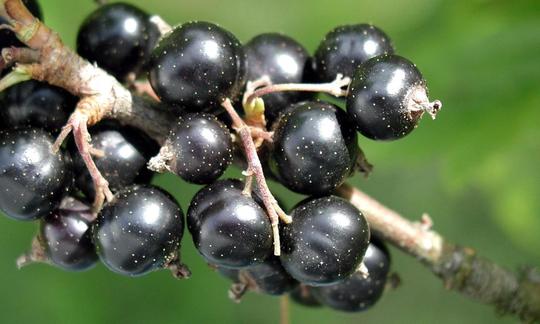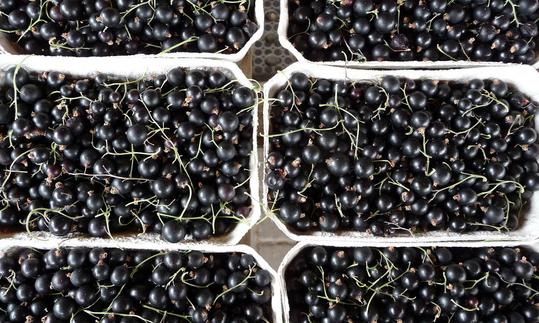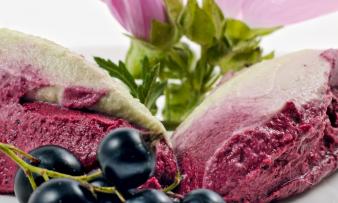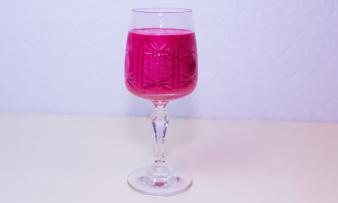Table of contents
Blackcurrants ( black currants , cassis ) have a very high vitamin C content. As juice, they are a tonic for colds and weakened health.
Use in the kitchen:
Black (that's part of the name!) currants are mainly used to make juice, syrup (cassis syrup), sorbet or chutneys. The black berries are also a treat in desserts. The berries taste particularly refreshing on cakes and pastries, but also in smoothies, and give a beautiful color. They add variety to muesli, e.g. pea muesli . For milder variants, use red currants or white currants , a cultivated form of the red variety. Red and white currants are also popular raw.
In addition to their sweet and sour aroma, black currants also have an astringent and bitter taste. Some people find the peculiar smell of the plant and the taste of the berries unpleasant, some describe it as "bug-like". This taste disappears after drying the leaves and cooking the berries.
Like all currants, black currants are also suitable for making jams or jellies. The high pectin content of black currants means that preservatives can be omitted and the amount of sugar can be significantly reduced. The citric acid they contain gives them a fresh, sour note and acts as a natural preservative.
The famous Cassis liqueur is made from black currants. Blackcurrants are also used for the aperitif "Kir". It consists of white wine with crème de cassis. If the cocktail is prepared with champagne, it is called "Kir Royal". The "Cumberland sauce", which first appeared in cookbooks in 1904, contains red currants, as does the "Red Grütze".
In addition to the berries, the young leaves are also useful. It is important to ensure that they are free of mold (mildew). In the Middle Ages, the mostly dried leaves were used to season soups, as tea or for medicinal purposes. 1
Making tea from blackcurrants:
Dried cassis berries also taste particularly good when brewed as tea. One tablespoon of dried berries is enough for one cup.
The best way to dry blackcurrants is in a dehydrator. The drying times vary depending on the model of the device and the size of the fruit. In the oven at 40-50 °C (circulating air), the drying process for small berries takes around 10 hours. A small gap in the oven must be left open so that the moisture can escape. For even drying, it is worth turning the berries every 2 hours. Gentle air drying of the berries is also possible. For example, in the attic or (in the heating season) next to the heater or fireplace. However, this can take several weeks. In this case, it is advisable to turn the berries daily to prevent mold from forming. 9
Blackcurrant tea not only helps with colds, but is also said to have a soothing effect on rheumatism and gout.
Recipe for chutney with black currants:
Ingredients: 250 g black currants, 2 red onions , 1 pear , juice of an orange , 1 small chilli pepper , 50 ml white wine vinegar , 100 g raw cane sugar, 1 teaspoon salt , 1 tablespoon rapeseed oil .
Preparation: Peel the onions and dice them. Remove the seeds from the chilli pepper and dice them too. Sauté these ingredients briefly in the oil. Deglaze with orange juice and vinegar. Then add the sugar, peeled and diced pear and the currants. Add salt and simmer over a low heat for about 1 hour until the liquid has evaporated. The chutney should have a viscous consistency. Stir regularly to prevent the mixture from burning. Pour the chutney into well-rinsed jars while it is still hot. This way it will keep for a long time.
Vegan recipes with blackcurrants can be found under the note: " Recipes that have the most of this ingredient ".
| Not only vegans or vegetarians should read this: Vegans often eat unhealthily. Avoidable nutritional mistakes . |
Shopping - where to buy?
It is best to buy blackcurrants fresh when they are in season. Supermarket chains such as Coop , Migros , Denner , Volg , Spar , Aldi , Lidl , Rewe , Edeka , Hofer etc. rarely offer blackcurrants, they mainly sell red ones. Blackcurrants are also available in organic shops, at weekly markets or in fruit and vegetable subscription boxes.
Cassis juice made from black berries is often available in health food stores. But many industrially produced juices contain high amounts of sugar. If you don't make the juice yourself, make sure you buy organically produced juice with no added sugar.
With fresh currants, it is important that they look plump and undamaged. If the clusters still have fresh, green leaves, it is worth buying them. Before eating, sort out the mushy berries and wash the rest. Make sure they are organic if you use or eat berries regularly.
Found in the wild - Season:
In Central Europe, black currants are in season from July to August.
Blackcurrants grow wild in alder groves, damp bushes and floodplain forests. 2
Storage:
If stored for too long, the anthocyanins in blackcurrants break down through decay and combination with sugar components. That's why it's best to eat them fresh. The blackcurrants will last 2-3 days in the fridge - or you can freeze them for later use. If made into juice, jam or jelly, they will last a long time. The loss of vitamin C during preservation is relatively low for this berry fruit. 1
Ingredients - nutritional value - calories:
Blackcurrants have slightly less acid than red ones, but more bitter substances.
Currants contain a lot of vitamin C , especially black currants (up to 190 mg/100 g 1 ). This is more than three times as much as lemons (53 mg/100g) and more than is found in red bell peppers (128) and yellow bell peppers (184). 3
Substances were also found that have a structure similar to vitamin C, which was referred to as vitamin I or vitamin J. 6 The content of secondary plant substances - such as anthocyanins (130 - 400 mg/100 g fruit) and flavonoids - is also particularly high. With a proportion of 0.8 - 1.5%, the pectin content is even significantly higher than in apples. The content of terpenes (beta-pinene and caryophyllene) is interesting due to its antimicrobial effect.
In addition, blackcurrants have higher levels of fruit acids (citric acid, malic acid, tartaric acid), potassium , iron and even alpha-linolenic acid (ALA, or omega-3 fatty acid). 3 More information on the nutrient and trace element content can be found in the table after the text.
The complete ingredients of black currants, the coverage of the daily requirement and comparison values with other ingredients can be found in our nutrient tables. In the article Nutrients explained you will get a detailed insight into the topic.
Ratio of omega-6 (LA) to omega-3 fatty acids (ALA) in berries:
Berries and wild berries usually have a very good ratio of LA (linoleic acid) to ALA (alpha-linolenic acid) . In general, berries have a low fat content and the amounts of omega-3 and omega-6 are accordingly low. In relation to the total fat content, however, the polyunsaturated fatty acids make up a high proportion.
The body uses alpha-linolenic acid to produce other omega-3 fatty acids (EPA and DHA), which have an anti-inflammatory effect, while linoleic acid is used to produce arachidonic acid, which has an inflammatory effect. The good ratio of omega-6 to omega-3 is another reason why the berries are considered a very healthy food.
Information on individual values ALA and LA (source: USDA, Önwt, Debinet):
Berry (raw) | L.A. (g/100g) | ALA (g/100g) | Ratio LA:ALA | Total fat (g/100g) | source |
2.6 | 1.8 | 1.5:1 | 7.1 | Önwt | |
0.6 | 0.5 | 1:1 | 1.7 | Önwt | |
0.19 0.4 0.36 | 0.09 0.3 0.26 | 2:1 1.25:1 1.3:1 | 0.34 1.0 1.0 | USDA Önwt Debinet | |
Forest Blackberry | 0.4 | 0.3 | 1.25:1 | 1.0 | Önwt |
0.2 | 0.2 | 1:1 | 0.5 | Önwt | |
0.3 | 0.2 | 1.5:1 | 0.7 | Önwt | |
0.2 0.22 | 0.2 0.15 | 1:1 1.5:1 | 0.6 0.6 | Önwt Debinet | |
0.25 0.1 | 0.13 0.1 | 2:1 1:1 | 0.46 0.3 | USDA Önwt | |
Forest Strawberry | 0.1 | 0.1 | 1:1 | 0.4 | Önwt |
Forest Raspberry | 0.1 | 0.1 | 1:1 | 0.3 | Önwt |
Boysenberry | 0.11 | 0.08 | 1.5:1 | 0.3 | Debinet |
Blackcurrant | 0.11 | 0.07 | 1.5:1 | 0.26 | USDA |
0.09 | 0.06 | 1.5:1 | 0.21 0.4 | USDA Debinet | |
0.27 | 0.05 | 5:1 | 0.4 | USDA | |
0.05 0.04 | 0.04 0.03 | 1:1 1.25:1 | 0.13 0.2 | USDA Debinet |
Health aspects - effects:
According to the German Bechterew's Disease Association, black currants are considered effective against Bechterew's disease (chronic rheumatic disease). The high vitamin C content has a positive effect on the immune system and reduces chronic inflammatory processes. Vitamin C is a radical scavenger because it neutralizes free radicals. 1
The anthocyanins contained in the fruit also have an anti-inflammatory effect. They are usually associated with a red to black-blue or violet color. Anthocyanins are secondary plant substances, more precisely polyphenols. Blackcurrants, like aronia berries , elderberries and blueberries, are among the types of fruit with the most anthocyanins. The substances are mainly found in the peel, which is why the juice is not as effective as the whole fruit. Blackcurrants also contain flavonoids (antioxidants) that have an antioxidant effect. 1
The high proportion of fiber and pectin has a positive effect on the intestinal flora. This lowers the pH value in the intestine, which benefits beneficial intestinal bacteria such as bifidus and lactobacillus bacteria. Consequently, currants can be described as prebiotic foods. Pectin also delays the absorption of sugar, which has a positive effect on the metabolism. 1
According to the Blackcurrant Foundation in Great Britain, the secondary plant substances in blackcurrants are effective against various cardiovascular diseases, cancer and infections. The antioxidant effect of the berries helps to strengthen the immune system and has positive effects on neurological dysfunctions (eg Alzheimer's, Parkinson's, dementia). 4
Folk medicine - natural medicine:
In folk medicine, the juice is often used to treat coughs, hoarseness, colds and acute and chronic diarrhea. Dried currants also help with urinary problems. 5
Externally , black currants are said to provide relief from sore throats , insect bites and wounds.
ESCOP ( European Scientific Cooperation on Phytotherapy ) and HMPC ( Committee on Herbal Medicinal Products ) recognize blackcurrant as a traditional herbal medicinal product thanks to its positive effects.
Occurrence - Origin:
The black currant comes from the European-Asian region, mainly from the forest area. People have been cultivating it in gardens since the 16th century. Today, a wide variety of varieties are grown, preferably as shrubs, sometimes at up to 2000 m above sea level.
Cultivation - Harvest:
The robust shrub loves moist to wet locations with nutrient-rich, boggy to clayey soil. If the black currant grows wild in gardens, it can also grow in dry locations. 2 It does not tolerate waterlogging or extreme heat well. Black currants grow more vigorously than red or white currant bushes, they can reach a height of 2 m. The fruits grow on the 1- to 2-year-old shoots and the shrub requires little care.
Approximately three months after flowering (April - May), the black cassis berries are ready for harvest, depending on the location (in Central Europe from July to August). 1
General information:
The blackcurrant ( Ribes nigrum ) belongs botanically to the gooseberry family (Grossulariaceae), but has no thorns. It is one of the few fruit species that have been native to Central Europe for thousands of years. 7
From the 12th century onwards, the seed oil of the black currant was used to treat skin diseases. In 1712, the doctor and clergyman Bailly Montaran mentioned the multiple healing effects of the black currant.
The perfume industry uses the flower bud extract to give their fragrances a fruity note. The seeds have a high content of gamma-linolenic acid, which is interesting for the cosmetics industry. 6
Alternative names:
Other common names for the blackcurrant are: Ahlbeere, Alpenbeere, Bocksbeere, Gichtbeere/Gichtstock, Salbeere, Schwarze Zeitbeere, Stinkstrauch, Wanzenbeere, Vogeltrauben, Schwarze Träuble, Kanstraube, Meertrübeli. 5 The English name is blackcurrant or black currant.
Literature - Sources:












Comments